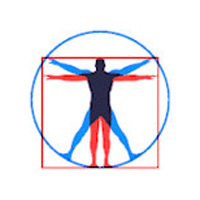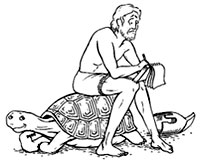
Reflections on Science
by Alberto Viotto Articles index
An unconventional solution for the “Achilles and the tortoise” paradox
January 2009
-
Zeno of Elea
-
The usual solution
-
Quantum mechanics point of view
-
Uncertainty
-
When Achilles is near the tortoise
-
Zeno was right
Zeno of Elea
The widely known Achilles and the Tortoise paradox was created by the Greek philosopher Zeno of Elea (ca. 490 BC – ca. 430 BC). Achilles, who is known for his speed, and the slow tortoise meet for a race, that we will describe using J.L. Borges’s words:
Achilles runs ten time faster than the tortoise and gives the animal a headstart of ten meters. Achilles runs those ten meters, the tortoise one; Achilles runs that meter, the tortoise runs a decimeter; Achilles runs that decimeter, the tortoise run a centimeter, and so on to infinity.
Zeno, who wanted to show that the evidence of our senses is misleading and that motion is nothing but an illusion, ended up by stating that Achilles will never be able to reach the tortoise.
 The usual solution
The usual solution
The most common solution to this paradox analyses the sum of the infinitely many terms that get progressively smaller. If Achilles takes nine tenths of a second to run the first ten meters, in the same time the tortoise will have gone one meter farther. It will take Achilles nine hundredths of a second to cover that meter, nine thousandths of a second to cover the next decimeter and so on. The sum of the necessary time slices (here given in seconds) will therefore be:
0.9 + 0.09 + 0.009 + 0.0009 + ...
From the point of view of a mathematician, the sum of these infinite terms is a convergent series, and its value is one. Time continues to flow, however, as we all know. Zeno only demonstrated that Achilles will not manage to reach the tortoise before a certain amount of time has elapsed (one second according to our premises). As time continues to flow, Achilles will reach and overtake the tortoise.
We can’t, however, be fully satisfied with this explanation. Can there really be a moment after the never ending series of moments, during each of which Achilles will have reached the point where the tortoise has just been? Is it possible for time to continue flowing until the moment when the tortoise is reached?
In order to be able to answer those questions, we should think about our usual view of reality. We all usually think that in the world outside us objects exist, which are ruled by precise laws. Entities like Achilles and the tortoise have certain properties; among them a path that can be known with arbitrary precision.
Quantum mechanics point of view
Quantum mechanics gives us a different view of the world, according to the so called Copenhagen interpretation, proposed by the Danish physicist Niels Bohr in 1927. In quantum mechanics you cannot exactly describe what happens in the world around us. Let’s make an example: if we attempt at measuring the position of a particle, we will only be able to define the probability of obtaining each of the possible outcomes from measuring it. Quantum mechanics does not pinpoint the exact value for the position of a certain particle, but it only provides a range of probabilities of where that particle might be. The root-mean-square deviation of the position from its mean is called uncertainty and its value cannot be zero.
In the light of the Copenhagen interpretation it is no longer possible to establish a model of the world which gives it an exact shape. Electrons, for instance, behave in a very particular way. Quantum mechanics allows us to predict measurements results instead of providing us with a model of the world outside us.
Uncertainty
According to quantum mechanics, pairs of conjugate “observables”, such as the position and the momentum (that is, the product of mass and speed) of a particle, cannot simultaneously be known with infinite precision. The more precisely one variable is known, the less precisely the other will be known. This is not an assertion about the limitations of our ability to measure particular quantities of a system, but rather about the nature of the system itself.
The degree of uncertainty is given by multiplying the deviation of the position from its mean by the deviation of the momentum from its mean and can never be smaller than a fixed fraction of Planck's constant. The value of this constant, that is expressed in kilograms multiplied meters per second (the measurement unit for momentum) multiplied meters (the measurement unit for position) can be represented by 1 divided by a number which can be written as “1” followed by thirty-four zeros.
If we have an object that weighs 1 kilo and the uncertainty of its position is one millionth of a billionth of a millimeter, quantum mechanics states that the uncertainty of its speed can’t be less than a millionth of a billionth of a millimeter per second. Such kind of uncertainty is of no practical use if we have to measure meters, millimeters or even thousandths of millimeters.
When Achilles is near the tortoise
What happens when Achilles is just about to reach the tortoise? The initial 10 meters distance will be reduced to a tenth of a millimeter, then to a billionth of a millimeter (in only eight steps) and further on to a millionth of a billionth of a millimeter. After a few dozens of steps we will have to deal with dimensions where quantum mechanics can’t be disregarded.
According to quantum mechanics, Achilles and the tortoise are not objects which we can describe with infinite precision; we can only take measurements and predict their results. However, the distance between them is soon becoming so small that even taking a measurement would be pointless: uncertainty would be too prominent.
The keynote of this argument does not regard our ability to measure. In this case there is no point in measuring, not even from a theoretical point of view. Uncertainty is a property which is intrinsic to the nature of any entity we want to measure.
If we accept the idea that a scientific theory should not provide us with an image of the world, but it should only be used for improving our knowledge, and if we say that an entity, such as a length interval, cannot be measured, not even from a theoretical point of view, this means that we must avoid such an entity in our view of the world. This entity, simply, doesn’t exist.
After a short time, the distance between Achilles and the tortoise doesn’t exist anymore. We can state that the pursuer has reached his aim.
Zeno was right
Achilles’s victory in the race does not show that Zeno was wrong, as his aim was to prove that motion does not exist. A similar statement can be found in quantum mechanics. As the Russian physicist Lev D. Landau, who was awarded the Nobel prize in 1962, wrote in the first chapter of his book “Quantum mechanics”, third volume of his most famous “Course of Theoretical Physics”:
“In quantum mechanics there is no such concept as the path of a particle. This forms the content of what is called the uncertainty principle, one of the fundamental principles of quantum mechanics, discovered by W. Heisemberg in 1927”
Quantum mechanics introduced uncertainty as a principle which is relevant only in the subatomic world; that is due to the small value of Planck’s constant. Its relevance, however, is of general interest, and it could make us think about our conception of the world from a different point of view. We don’t need to think that, in the world outside us, there must be entities that “exist” and are subject to infinitely precise rules. We don’t need to think that motion “exists”; what matters is that we can take measurements and predict their outcomes. In our exam of the race between Achilles and the tortoise, only this unconventional point of view prevents us from coming to a dead end.
Alberto Viotto
The Italian page (including italian articles, a free ebook about paradoxes, a video of an interview about the ebook “Computers’ revenge”): Riflessioni sulle Scienze